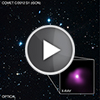CXC Home | Search | Help | Image Use Policy | Latest Images | Privacy | Accessibility | Glossary | Q&A
Tour of Comets ISON & PanSTARRS
Quicktime MPEG With closed-captions (at YouTube)
People on Earth have been watching comets in the sky for many thousands of years. Although many ancient cultures saw comets as signs of impending danger, today scientists know that comets are really frozen balls of dust, gas, and rock. They may have been responsible for delivering water to planets like Earth billions of years ago.
It may surprise people to hear that comets can provide information about other aspects of our Solar System. In particular, comets can be used as laboratories to study the behavior of the stream of particles flowing away from the Sun, known as the solar wind.
Recently, astronomers have performed such a study using observations with Chandra of two comets, named ISON and PanSTARRS. Chandra observed these two comets in 2013 when both were relatively close to Earth.
Scientists know that comets produce X-ray emission when particles in the solar wind strike the atmosphere of the comet. The Chandra data allowed scientists to estimate the amount of elements like carbon and nitrogen in the solar wind. They found values that agree with those from other missions, showing the value of X-ray observations for deriving the composition of the solar wind.
[Runtime: 02:21]
Quicktime MPEG With closed-captions (at YouTube)
People on Earth have been watching comets in the sky for many thousands of years. Although many ancient cultures saw comets as signs of impending danger, today scientists know that comets are really frozen balls of dust, gas, and rock. They may have been responsible for delivering water to planets like Earth billions of years ago.
It may surprise people to hear that comets can provide information about other aspects of our Solar System. In particular, comets can be used as laboratories to study the behavior of the stream of particles flowing away from the Sun, known as the solar wind.
Recently, astronomers have performed such a study using observations with Chandra of two comets, named ISON and PanSTARRS. Chandra observed these two comets in 2013 when both were relatively close to Earth.
Scientists know that comets produce X-ray emission when particles in the solar wind strike the atmosphere of the comet. The Chandra data allowed scientists to estimate the amount of elements like carbon and nitrogen in the solar wind. They found values that agree with those from other missions, showing the value of X-ray observations for deriving the composition of the solar wind.
[Runtime: 02:21]
(Credit: NASA/CXC/A. Hobart)
Return to Comets ISON & PanSTARRS (April 18, 2016)



